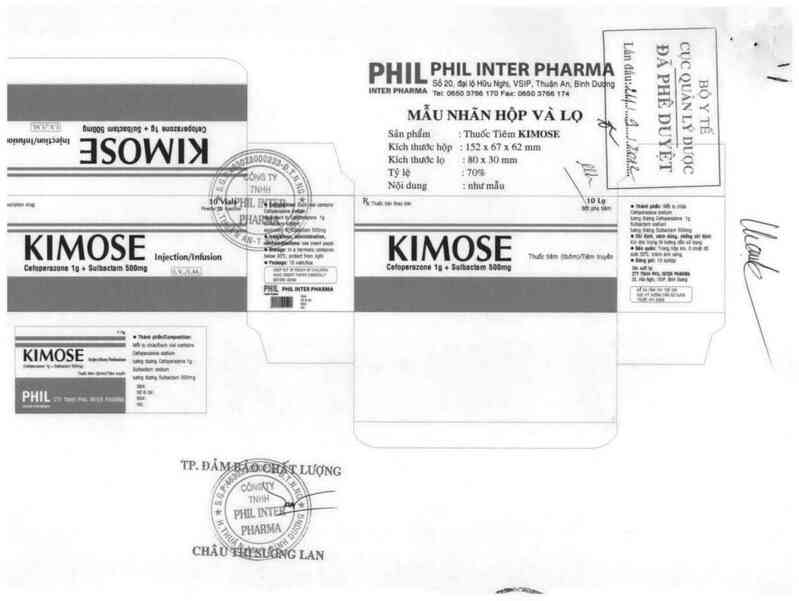
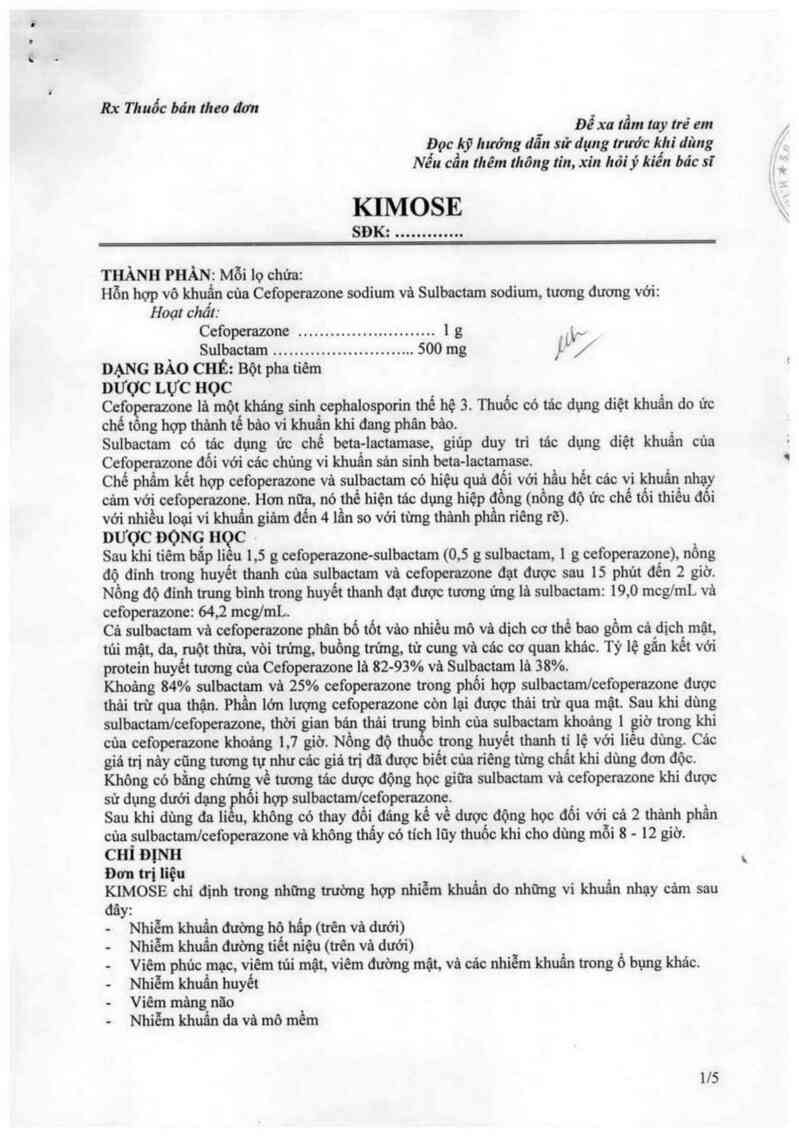

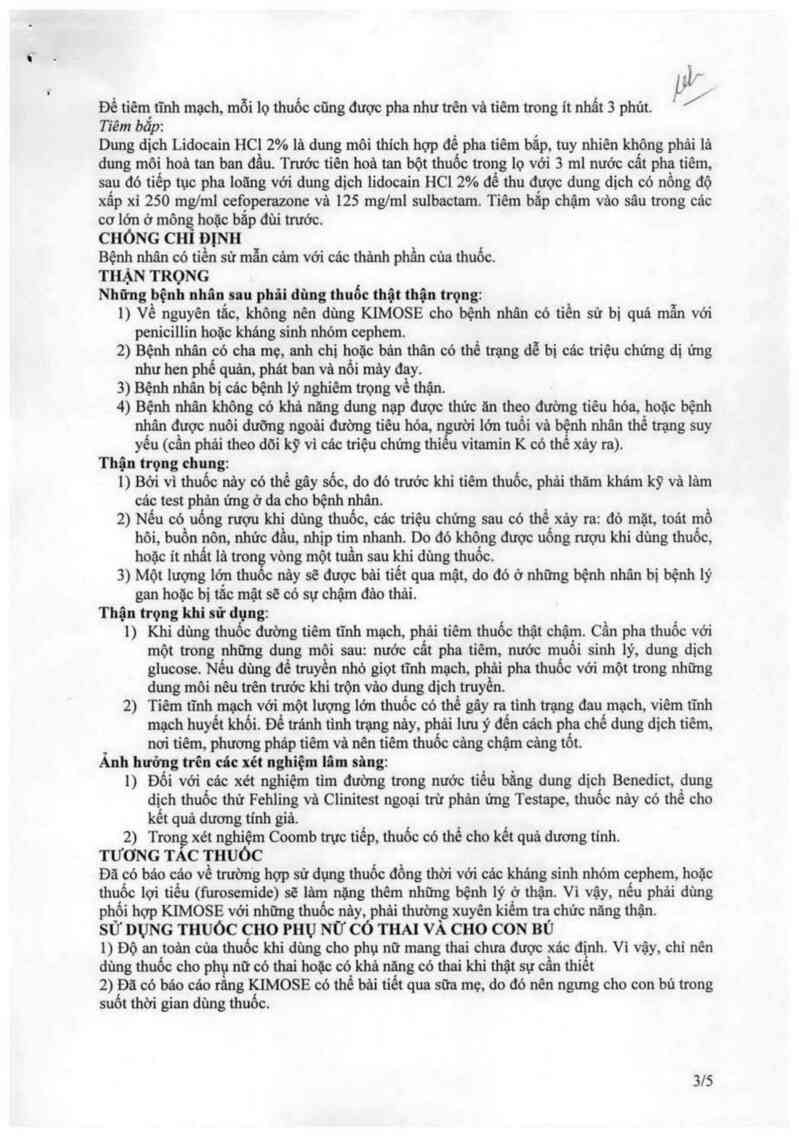
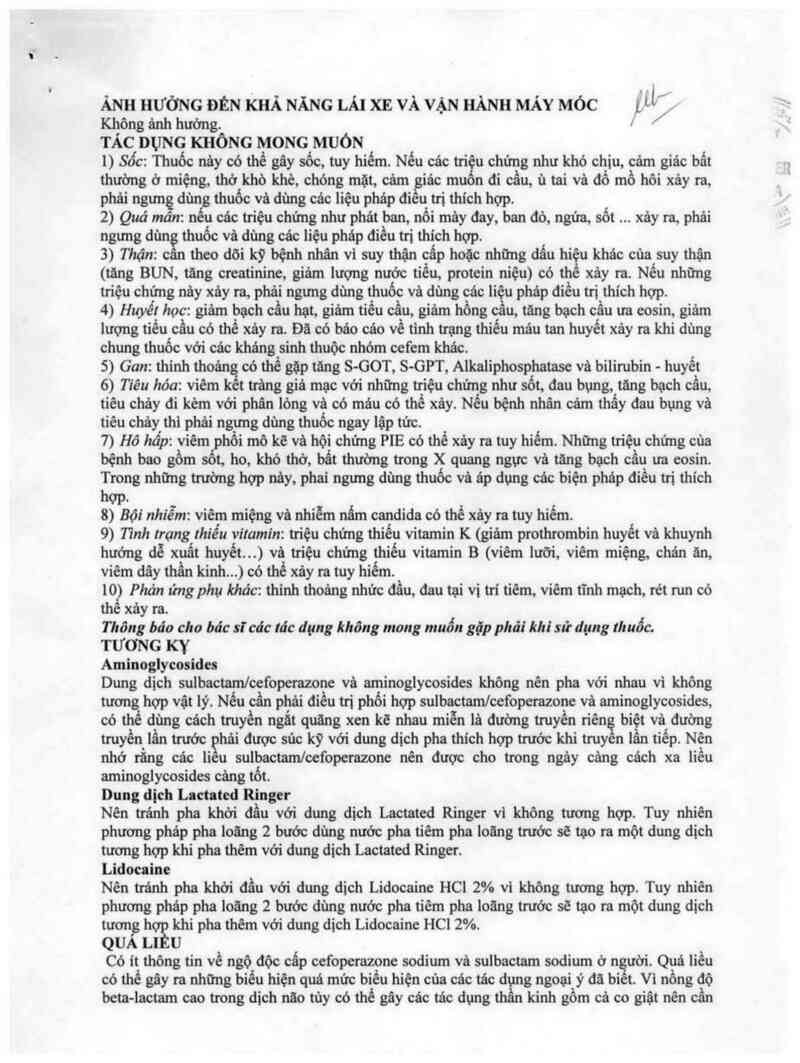
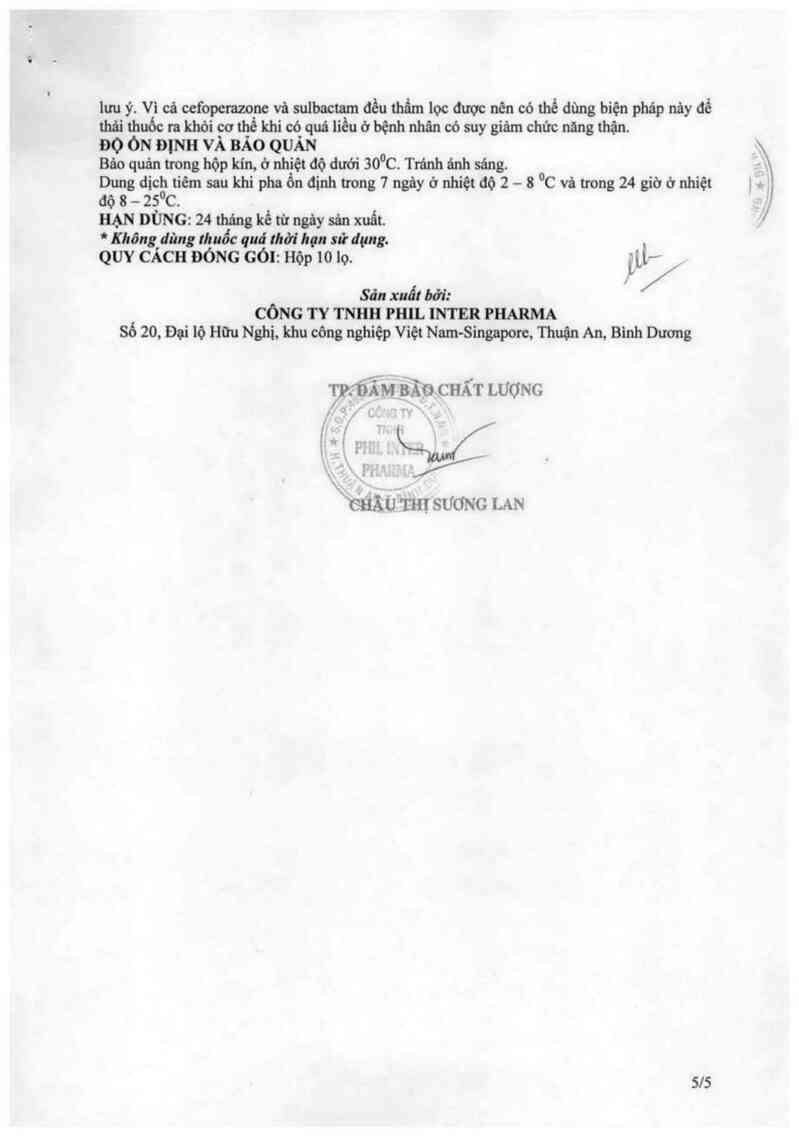
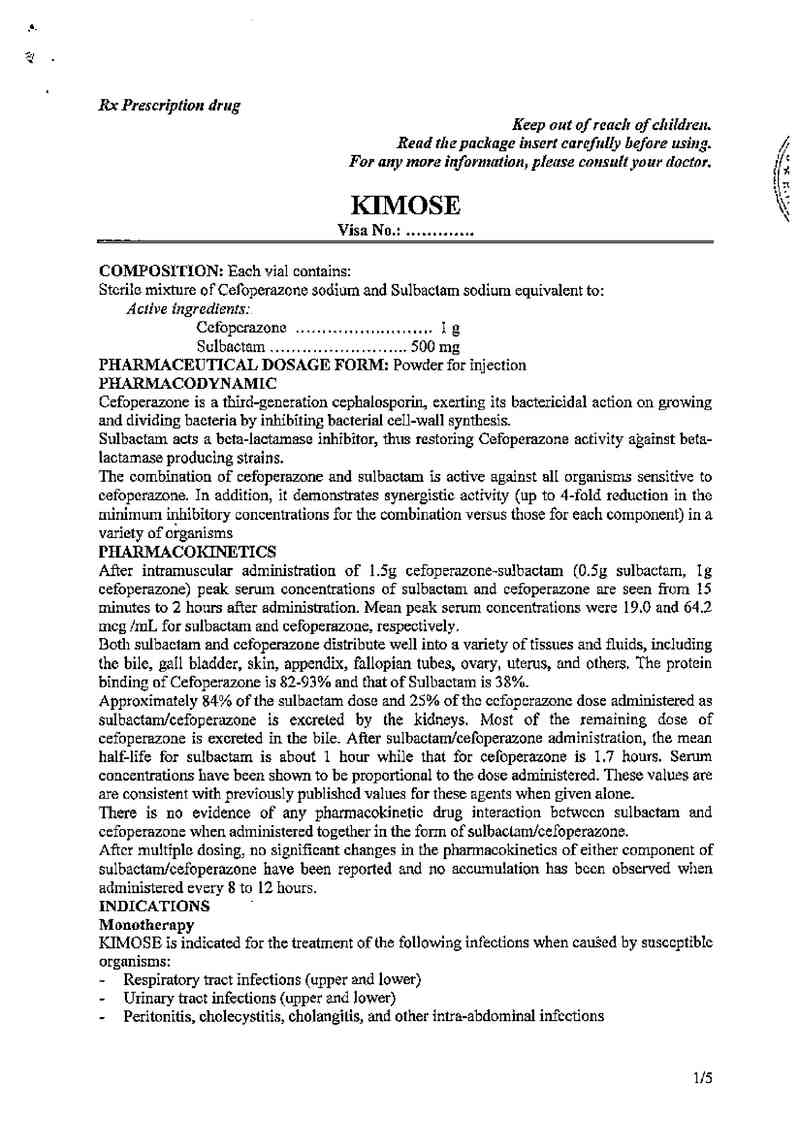
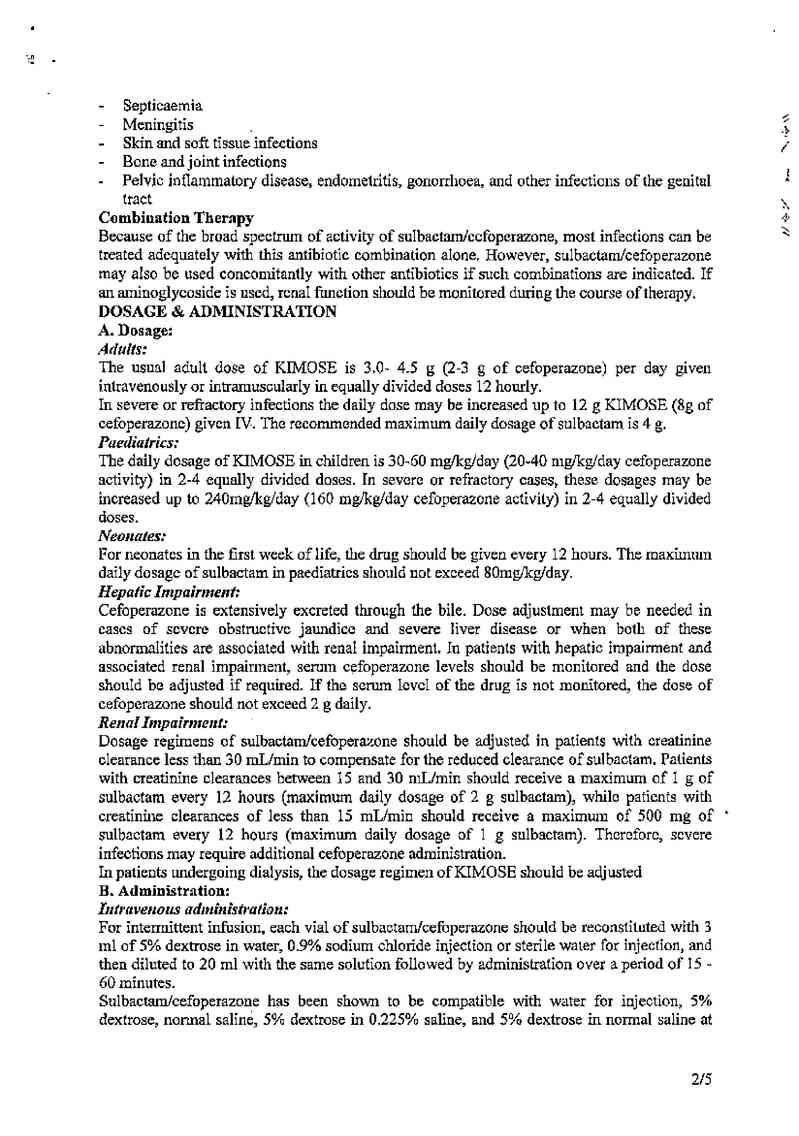
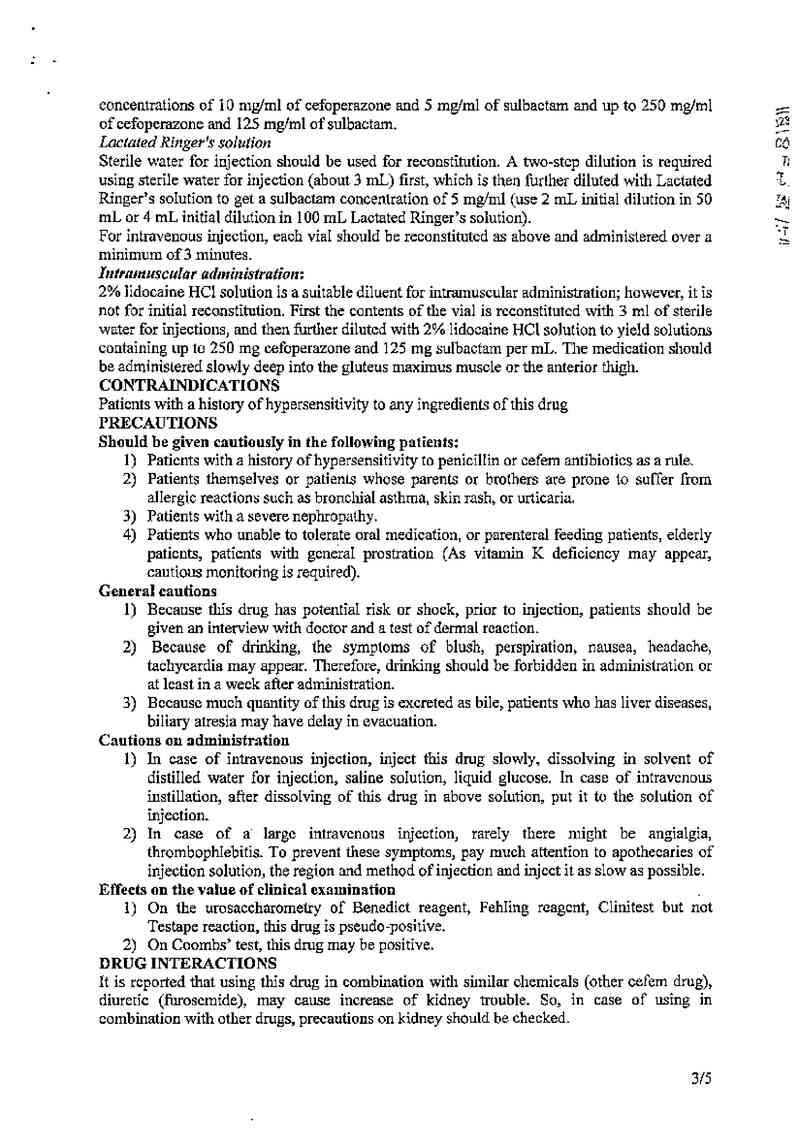
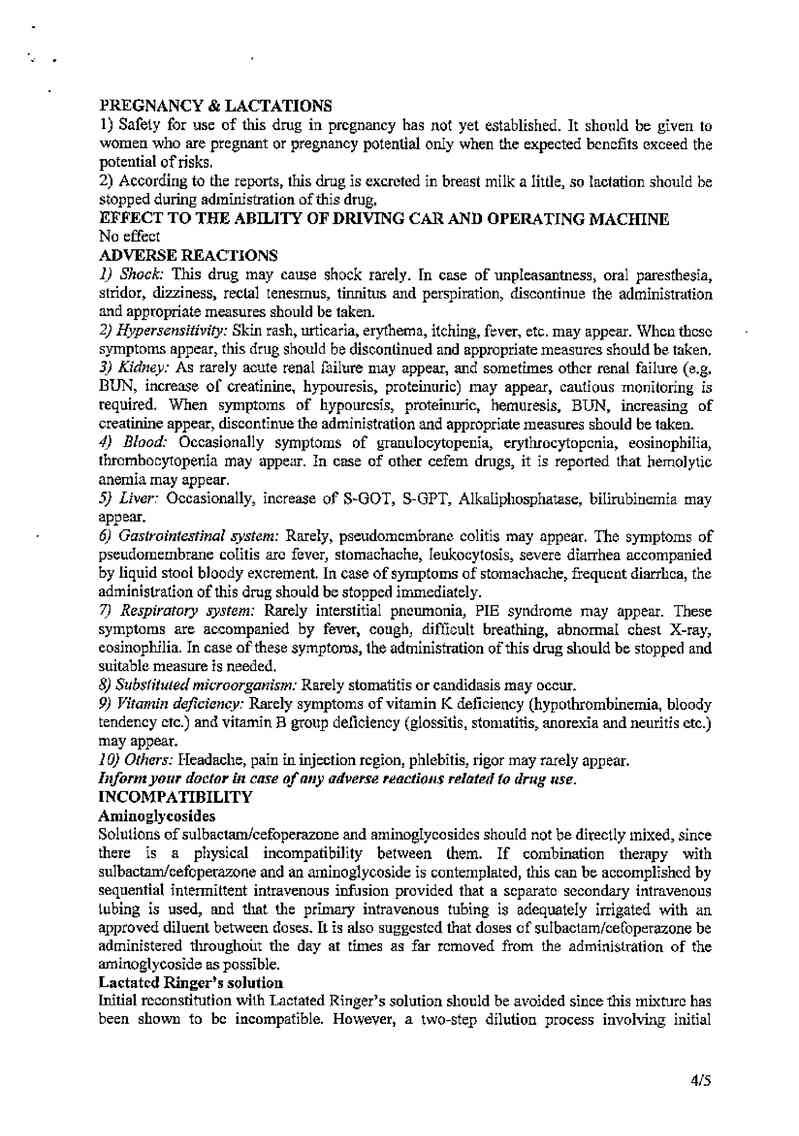

ẽ- Ẹ s—.
!
PH|LPHIL INTER PHARM Ệ~ ~u 2
sozo.ouLouou '.VSiP,T A.th -- m
mưanuam m:ossosm 11Ủuxzoosoatiẹenwz Ề = Ẹ_C›
x ~ \ Ệ m) 2 ’<
______ MAU NHAN HÒP VA LỌ ủ g L— _,
“"ặụ MWWWW Sân phím :ThuốcTiém xmoss ả` C ị m’~
W'M ' JSOWI›I chthu0chộp :152x67x62mm ẫề° '< …—_
_ _ Kích thưđL:lọ :souo mm ỏ_ ạt "E C
`r _ -_ Tỷlệ :1ma :: sỹ“ Ổ
, Nộidung :nhưmãu ?
…… , R….…… Ji… _…__f_ÌỞ
" ,…“:f:_ạ…..
ln!me
°UỤ-Umnnuụ
lnưmhmdnwm
°*dmmwuoun
KIMOSE MM…(MMVNLLLMLL Mứtmmm.
olqựm…
Wtuhlhchnũlu com…mowmum
iỈ.V.fLMg
'h
o…m
_ lún…nuun
KIMOSE … ……_…~,
munumn-uuu '
Lnuu…uú ……
uu
Ilu
w
lL
Rx Thuốc bản theo …
Đế xa tẩm !ay trẻ em
Đọc kỹ hướng dẫn sử dụng trước khi dùng
Nếu cẩn thêm thông tỉn, xỉn hỏi ý kiến bđc sĩ
THÀNH PHÀN: Mỗi Lọ chứa:
Hỗn hợp vô khuấn của Ccfoperazone sodium vả Sulbactam sodium, tương dương với:
Hoạ! chất:
Cefoperazone .......................... 1 g i~
Sulbactam ........................... 500 mg li" /
DẠNG BÀO an: Bột pha tiêm
DƯỢC LỰC HỌC
Cefo mone lá một kháng sinh ccphalosporin mé hệ 3. Thuốc có tử dụng diệt khuấn do ức
chết nghợpthènhtếbảovikhuấnkhiđangphânbảo.
Sulbactam có tảc dụng ức chế bcta—lactamase, gỉủp duy tri tác dụng diệt khuẩn của
Cefopetazone đối với các chủng vi khuẩn sán sinh beta—lactamase.
Chế phẩm kểt hợp ccfoperazonc vả sulbactam có hiệu quả đối với hầu hết cảc vi khuẩn nhẹ
cám với cefopcrazone. Hơn nữa, nó thể hiện tảc dụng hiệp dồng (nồng dộ ửc chế tối thiểu d i
với nhiều loại vi khuẩn giám đến 4 lần so với từng thùnh phẩn riêng rẽ).
DƯỢC ĐỌNG HỆC
Sau khi tiêm bắp li u 1,5 g ccfopctmnc—sưlbactam (0,5 g sulbactam, 1 g cefopcrazone), nổng
độ dinh trong huyết thanh cùa sulbactam vả ccfopemzonc dạt được sau 15 phủt dến 2 giờ.
Nồng độ dinh trung binh trong huyết thanh đạt được tương ứng là sulbactam: 19,0 mcglmL vả
cefopcrazonc: 64,2 mcg/mL.
cn sulbactam vả ccfopcramnc phân bố tốt vảo nhiều mỏ và dich cơ LLLé bao gồm cá dich mật,
tủi mật, da, ruột thừa, vòi trứng, buồng trứng, tử cung vả các cơ quan khác. Tỷ lệ gắn kểt với
protein huyết tương cùa Ccfoperazonc lả 82-93% vả Sulbactam LL 38%.
Khoảng 84% sưlbactam vù 25% ccfopcrazonc trong phối hợp sulbactamlcefoperazone được
thải trừ qua thận. Phần lớn lượng ccfopcramnc còn lại dược thải trừ qua mật. Sau khi dùng
sulbactaưưccfbpcrazonc. thời gian bản thâi mm bình của sưlbactam khoáng ] giờ trong khi
của ccfoperazonc khoáng 1,7 giờ. Nồng độ thuẵc trong huyết thanh ti lệ với liêu dùng. Cảc
giá trị nây cũng tương tự như các giá trị dã được biểt của riêng từng chẩt khi dùng đơn dộc.
Không có bằng chứng về tương tác dược động học giữa sulbactam vả ccfopcrazone khi được
sử dụng dưới dạng hối hợp sulbactanưccfoperazone.
Sau khi dùng đa li ư, không có thay dồi đáng kể về dược động học dối với cá 2 thảnh phần
cùa sưlbactamlccfopcmzonc và không thấy có tích lũy thuốc khi cho dùng mỗi 8 — 12 giờ.
cui ĐỊNH
Đơn trị liệu
KIMOSE chi dịnh trong những trường hợp nhiễm khuấn do những vi khuấn nhạy cám sau
dây:
— Nhiễm khuẩn đường hô hấp (trên và dưới)
… Nhiễm khuẩn đường tiết niệu (trẽn vè dưới)
~ Viêm phủc mạc, viêm túi mật, viêm dường mật, vả các nhiễm khuấn trong ổ bụng khác.
~ Nhiễm khuẩn huyềt
— Viêm mèng não
- Nhiễm khuấn da vù mô mềm
IIS
. i,
ztí/
- Nhiễm khuẩn xương khớp
- Viêm khung chậu, viêm nội mạc tử cung, bệnh lậu và các nhiễm khuấn đường sinh dục
khảc
Điều tri kết hợp
Do hỗn hợp sulbactanưcefoperazone có phổ kháng khuẩn rộng nên chỉ cằn sử dụng đơn thuần
cũng có thể điều trị hữu hiệu hẩu hết các trường hợp nhiễm khuấn. Tưy nhiên,
sulbactamlccfoperazonc có thể dùng kết hợp với những kháng sinh khảc nếu cẩn. Khi kểt hợp
với aminoglycosid, cấn tth dõi chức năng thận trong suốt quá trình điều trị.
LlỀU LƯỢNG vA cÁcn DÙNG
A. Liều lượngz
N ườL' lởm
Li u thường dùng cùa KIMOSE lè 3,0— 4,5 g (2—3 g cefopcrazonc) mỗi ngảy. chia 2 lần cách
nhau 12 giờ, tiêm bãp hoặc tĩnh mạch.
Đối với các nhiễm khuẩn nặng: liều hảng ngảy cùa KIMOSE có thể tăng đển l2g (8g
cefoperazone), dùng theo đường tĩnh mạch. Liều Sulbactam hâng ngảy tối da LL 4g
T rẻ em:
Liều hảng ngảy cùa KIMOSE cho trẻ cm lả 30-60 mg/kg thể trọng (20-40 mg
cefoperamnelkg/ngử), chia 24 lần. Đối với các nhiễm khuấn nặng, có mè tăng liều lên đến
240mg/kg/ngây (cefopemzone 160 mglkg/ngây), chia 2-4 lần.
Trẻ sơ sỉnh:
Đối với trẻ sơ sinh 1 tuần tuổi, nên dùng thuốc mỗi 12 giờ. Liều tối đa sulbactam trong nhi
khoa không nên vượt quá 80mg/kg/ngảy.
Bệnh nhân suy gan:
Ccfoperazone được đâq thâi chủ yểu qua mặt. Cần điều chỉnh liều trong trường hợp bệnh
nhân bị ứ mật nặng, măc bệnh gan nặng hoặc khi bệnh nhân bị suy thặn đồng thời với mắc
bệnh gan hoặc mật. Đối với bệnh nhân vừa su gan vừa suy Lth cần phâi theo dõi nồng dộ
Cchpemzone tron máu vả điều chinh liều nấu cần thiết. Nếu không thế theo dõi nồng dộ
Cefoperazone huy t thanh, liều dùng hảng ngảy của Cefoperazone không nên vượt quá 2 g.
Bệnh nhân suy Illậrl:
Liều dùng sulbactam/cefopcrazonc nên điều chinh ở bệnh nhân suy giảm chửc nảng thận có
thanh thải creatinin < 30 lephủt để bù trừ sự giám thanh thải sulbactam. Bệnh nhân có thanh
thải creatinin từ 15-30 mL/phút dùng tối đa L g sulbactam mỗi 12 giờ (liều hảng ngây tổi đa 2
g sulbactam), trong khi đó nhũng bệnh nhân có thanh thải creatinin < 15 lephủt dùng tối da
500 mg sưlbactam mỗi 12 giờ (1iều hâng ngảy tối đa 1 g sulbactam). Trong trường hợp nhiễm
khưẩn nặng, có thể cần dùng thêm ccfopcrazonc.
Liều KIMOSE nên điều chinh ớ bệnh nhân thẩm phân.
B. Cảch dùng:
Dùng rheo đường tĩnh mạch:
Khi truyền ngắt quãng, mỗi lọ sulbactamlcefopcrazone phải được pha với 3 mL dung dịch
dextrose 5%, natri clorid o,9% hoặc nước vô khuấn dùng pha tiêm và sau đó pha loãng thảnh
20 mL với cùng dung dịch pha thuốc để tmyền trong khoảng 15—60 phủt.
Sulbactam/cefopermne tương hợp với nước cất pha tiêm, dextrose 5%, nước muối sinh lý,
dextrose 5% trong dưng dịch muối o,zzsv…, vè dextrosc 5% trong nước muối sinh lý với nồng
độ 10 mng ccfopcrazonc vả 5 mglml sulbactam cho đến 250 mg/mi cefoperazonc vả 125
mg/ml sulbactam.
Dung dịch Laclaled Ringer
Nên dùng nước cất pha tiêm để pha thuốc. Phải pha thuốc theo 2 bước, lần đẩu dùng nước cất
pha tiêm (khoảng 3 mL), rồi pha thêm với dun dich Lactated Ringer đề có nổng độ
sulbactam 5 mg/ml (dùng 2 mL dung dịch pha lần u thẽm 50 mL dung dich Lactatcd Ringer
hay 4 mL dưng dịch pha lều đầu thém mo mL dung dịch Lactatcd Ringcr).
Lti’
Đế tiêm tĩnh mạch, mỗi lọ thuốc cũng được pha như trên và tiêm trong ít nhất 3 phủt. ’ /
Tiêm bắp:
Dung dich Lidocain HCl 2% lá dưng môi thích hợp để pha tiêm bắp, tưy nhiên không phải là
dung môi hoả tan ban đầu. Trước tiên hoả tan bột thuốc trong lọ với 3 ml nước cất pha tiêm,
sau đó tiễp tục pha loãng với dung dich lidocain HCl 2% để thu được dung dịch có nổng dộ
xấp xỉ 250 mglml ccfopemzone và 125 mglmi sulbactam. Tiêm bắp chậm vảo sâu trong các
cơ Lớn ớ mông hoặc báp đùi trước.
CHỐNG cm mun
Bệnh nhân có tiền sử mẫn cám với các thảnh phần cùa thuốc.
THẶN TRỌNG
Những bệnh nhân sau phii dùng thuốc thật thận trọng:
1) Về nguyên tắc, không nén dùng KIMOSE cho bệnh nhân có tiền sử bị quá mẫn với
penicillin hoặc kháng sinh nhóm ccphcm.
2)Bệnhnhâncỏchamẹ,anhchi hoặcbánthâncóthểtrạngdễbicáctriệucht'mgdiứng
như hen phế quân, phát ban vè nổi nuLy đay.
3) Bệnh nhân bị các bệnh lý nghiêm trọng về thận.
4) Bệnh nhân không có khả năng dung nạp dược thức ăn theo đường tiêu hóa, hoặc bệnh
nhân được nuôi dưỡng ngoải đường tiêu hóa, 11 ườỉ lớn tuổi và bệnh nhân thể trạng suy
yếu (cằn phải theo dõi kỹ vi cảc triệu chủng thi u vitamin K có thể xảy ra).
Thận trọng chung:
1) Bởi vi thuốc nèy có mẻ gây sốc, do đó trước khi tiêm thuốc, phải ma… khám kỹ và lảm
các test phán ứng ở da cho bệnh nhân.
2) Nếu có uổng rượu khi dùng thuốc, các triệu chứng sau có thể xảy ra: dò mặt, toảt mồ
hôi, buồn nôn, nhức đẩu, nhip tim nhanh. Do đó không được ưống tượu khi dùng thuốc,
hoặc ít nhất là tron vòng một tuần sau khi dùng thuốc.
3) Một lượng lớn th nây sẽ dược bải tiết qua mật, do đó ở những bệnh nhân bị bệnh lý
ganhoặcbitãcmậtsẽcósựchậmđâotlúi.
Thận trọng khi sử dụng:
1) Khi dùng thuốc dường tiêm tĩnh mạan phải tiêm thuốc thật chậm. Cần pha thưốc với
một trong nhũng dung môi sau: nước cất pha tiêm, nước muối sinh 1ỷ, dưng dịch
glucose. Nếu dùng để truyền nhỏ giọt tĩnh mạch, phâi pha thuốc với một tmng những
dung môi nêu trên trước khi trộn vảo dung dịch truyền.
2) Tiêm tĩnh mạch với một lượng lớn thuốc có thể gây ra tình trạng đau mạch. viêm tĩnh
mẹch huyết khối. Để tránh tinh trạng nèy, anLi lưu ý đến cách pha chế dung dich tiêm,
_ nơi tiêm, phương pháp tiêm và nên tiêm thuốc cảng chậm cảng tốt.
Anh hưởng trên cảc xét nghiệm lim sèng:
1) Đối với các xét nghiệm tim đường Lmng nước tiểu bằng dung dich Benedict, dung
dich thuốc thử Fehling vả Clinitest ngoại mi phản ứng Testapc. thuốc nây có thể cho
kểt quá dường tinh giá.
2) Trong xét nghiệm Coomb trực tiếp, thuốc có thế cho kết quả dương tính.
TƯỢNG TAC THUỐC
Đã có báo cáo về trường hợp sử dụng thuốc đồng thời với các kháng sinh nhớm cephem, hoặc
thuốc lợi tiếu (fiưoscmidc) sẽ lâm nặng thêm nhũng bệnh lý ở thận. Vì vậy, nếu phải dùng
phối hợp KIMOSE với nhũng thuốc …Ly, phải thường xưyên kiềm tra chức nãng thận.
sử DỤNG THUỐC cno PHỤ NỮ có THAI VÀ CHO CON BỦ
!) Độ an toản của thưốc khi dùng cho phụ nữ mang thai chưa được xảc định. Vì vậy, chỉ nên
dùngthuốcchophụnữcótlmihoặccókhânăngcỏthaikhithậtsựcẫnthiết
2) Đã có báo cáo rằng KIMOSE có thể bèi tiết qua sửa mẹ, do đó nên ngưng cho con bú trong
suốt thời gian dùng thuốc.
3l5
ẤNH HƯỞNG ĐÊN KHẢ NĂNG LÁ] XE VÀ VẶN HÀNH MÁY MÓC )Li’ …
Không ảnh hướng. i /
TÁC DỤNG KHỎNG MONG MUÔN
l) Sốc: Thuốc nảy có thể gây sốc, tuy hiếm. Nếu các triệu chủng như khó chiu, cảm giảc bất
thường ở miệng, thớ khô khè, chóng mặt, cảm iảc muốn đi cầu, ù tai vả dổ mồ hôi xảy ra,
phái ngưng dùng thuốc và dùng các liệu pháp điẵu trị thích hợp.
2) Quá mản: nểu các triệu chửng như phảt ban, nồi mảy đay, ban đò, ngứa, sốt xảy ra, phải
ngưng dùn thuốc vả dùng các liệu pháp điều ni thích hợp.
3) Thận: theo dõi kỹ bệnh nhân vì sưy thận cấp hoặc những dấu hiệu khác của suy thận
(tăng BUN, tăng creatinine, giâm lượng nước tiểu, protein niệu) có thể xảy ra. Nếu những
triệu chứng nảy xáy ra, phải ngưng dùng thưốc và dùng các li u pháp điều trí thích hợp.
4) Huyết học: giảm bạch cẩu hạt, giảm tiếu cầu, giảm hổng u, tăng bạch cầu ưa eosin, giảm
lượng tiều cầu có thể xảy ra. Đã có báo cáo về tinh trạng thiếu máu tan huyết xảy ra khi dùng
chưng thưốc với các kháng sinh thuộc nhóm cefcm khác.
5) Gan: thinh thoản có mẻ gặp tăng s…oor, S-GPT, Alkaliphosphatase vả bilirubin … huyết
6) Tiêu hóa: viêm k t trâng giả mạc với những triệu chứng như sốt, đau bụng, tâng bạch cầu,
tiêu cháy đi kèm với phân lòng về có máu có thể xảy. Nếu bệnh nhân cảm thấy đau bụng và
tiêu chảy thì phải ngưng dùng thuôc ngay lập tức.
7) Hô hấp: viêm hổi mô kẽ vả hội chứng PIE có thể xảy ra tuy hiếm. Những triệu chủng cùa
bệnh bao gồm sốỉ ho, khó thớ, bất thường tmng X quang ngực và tăng bạch cầu ưa cosin.
Trong những trường hợp nây, phai ngưng dùng thuốc vả áp dụng các biện pháp điều trị thích
hợp.
8) Bộ! nhiễm: viêm miệng vè nhiễm nấm candida có thể xây ra tuy hiếm.
9) Tinh trạng thíếu viramin: triệu chứng thiếu vitamin K (giám prothrombin huyết và khuynh
hướng dễ xuất hưyết...) vả triệu chứng thiếu vitamin B (viêm lưỡi, viêm miệng, chán ăn,
viêm dây thần kinh…) có thể xây ra tuy hiếm.
10) Phản ứngphụ khác: thinh thoáng nhức đầu, đau tại vi tri tiêm, viêm tĩnh mạch, rẻt run có
thẻ xây ra.
Thông báo cho bđc sĩ cđc tác dụng không mong muốn gặp phăi khi sử dụng thuốc.
TƯỚNG KY
Aminoglycosida
Dưng dich sulbactamlcefoperazone vả aminoglycosides không nên pha vởi nhau vì không
tương hợp vật lý. Nếu cần phải điều trị phổi hợp sulbactam/cefopcrazone vả aminoglycosides,
có thể dùng cảch truyền ngắt quãng xen kẽ nhau miễn là đường truyền riêu biệt và đường
truyền lần trước hải được sủc kỳ với dung dịch pha thích họp trước khi L…yỄn lần tiếp. Nên
nhớ rằng các liễu sulbactam/ccfopemzone nên được cho trong ngảy câng cảch xa liều
aminoglycosides câng tốt.
Dung dich Lactated Ringcr
Nén tránh pha khời đẩu với dưng dich Lactated Ringcr vi không tuong hợp. Tuy nhiên
phương phảp pha loãng 2 bước dùng nước pha tiêm pha loãng trước sẽ tạo ra một dung dịch
tương hợp khi pha thêm với dưng dich Lactated Ringcr.
Lidocaine
Nên tránh pha khới đầu với dung dich Lidocaine HCl 2% vì không tường hợp. Tuy nhiên
phương pháp pha loãng 2 bước dùng nước pha tiêm pha loãng trước sẽ tạo ra một dung dịch
tươnf hĩẵ khi pha thêm với dung dich Lidocainc HCl 2%.
QU L U
Có ít thông tin về ngộ độc cấp cefopcrazone sodium vả sulbactam sodium ớ n ời. Quá liền
có thể găy ra những biền hiện quá mức biẻu hiện của cảc tác dụng ngoại ý đã biet. VL nồng độ
beta-lactam cao trong dich năo tùy có thể gây các tác dụng thần kinh gồm cả co giật nên cần
07
lưu ỷ. Vì cả cefoperazonc vả sulbactam đểu thẩm lọc được nên có thể dùng biện pháp nảy để
tháithưốcmkhòicơthểkhioóquáliềuớbệnhnhâncósuygiâmchức nãngthặn.
ĐỘ ỎN nnm VÀ BẨO QUẢN
Bảo quân trong hộp kin. ở nhiệt độ dưới 30°C. Tránh ánh sáng.
Dung dich tiêm sau khi pha ổn đinh trong 7 ngùy ở nhiệt dộ 2 - 8 0C và trong 24 giờ ở nhiệt
độ 8 - 25 c.
HẠN DÙNG: 24 tháng kể từ ngùy sản xuất.
* Không dùng thuốc quả thời hạn sử dụng.
QUY cAcn ĐỎNG GÓI: Hộp Lo Lọ. ỉLif
Săn xuất bởi:
cònc TY TNHH PHIL INTER PHARMA
Số 20, Đại lộ Hữu Nghi, khu công nghiệp Việt Nam—Singaporc, Thuận An, Binh Dường
TfflMẾẦB CHẤT LƯỢNG
| , _
| /
IIJ_ | `, LM
… .==:.
-'x_l — -
\ )ẢL,
`GHÂUTHỊ sươch LAN
5l5
LẺ
Rx Prescrịưử'm: đmg
Keep ơmf ofrcưcit ofcItfi'dren.
René rủrz pncỉmgc L'Liscrr cưrffln'ify ủefore LLJL'LLg.
For any mưre ínfnrmntían, pIense cmmuft ynLư n'ncfflr.
fflO.SE.
__ Visa Nu.:
COPLLIPỦSITION: Ench vial contains:
Stcrilc mixture of Cefoperawne sodium and Sulbactam sodium cquivalcnt to:
Active L'LLgL'EdL'ELLL'SJ.
Ccfopcrnzonc ig
Sulbfiũtffln SỦỦ mg
I’HÀRJHACEUTICAL DỦSLìGE FDRJ'FI: Powdcr for injection
PHARlVIACODYNAMIC
Ccfopcrazonc is a thỉJd-gcncrntion ccphalnsporin, cxcrting its bactcricidal action on growing
and divid'mg hactcria hy inhíhỉting bactcrial ccH-wall synthcsis.
Sulhactam acts a hcta-lnctamase ìnhihitor, thua rcstnring Cefopcrnzone L:LctivitLr a`gainst hnta-
lactamase prodưcing strains.
The combỉnation of ccfopcrazone and sulbnctam ỉs active against all orgmúsms sensitivc to
ccfopcrazone. In addition, it demnnstrntes synergistic activiig,ĩ [up to 4-fold reduction in the
minimum inhibỉtory cunccntrations for the. cưmbỉnation vcrsus those for cach cornponcnt) in a
LfaIiety of oi’gnnisrns
PI-[ARhLÂCỦKfflETICS
âftcr intramuscular administratiun of 1.5g ccfopcraznnc—sulbactam [[].Sg sulhactam, lg
ccfoperazone) pcak serum cnnccntratinns nf sulbactam and cefopcrazonc are Secn from 15
minutes to 2 hours after administratỉon. Mcan pcak scmm cnnccntratinns wcrc 19.0 and 64.2
mcg ÍmL for sulbactmn and ccfopcrazonc, rcspcctivcly
Both sulhactam nnd ccfopcrazunc distrihute wcll into a variety of tissucs and Íluids, including
the: bile, ga11 bladdcr, skin, appcndix, fallnpian tuhes, OVfit'jí, uterus, nnd others. The protein
bĩntỉing nf Ccfopcrazonc is 82-93% and that of Sulhactnm is 38%.
Àpproximntely 84% of the sulbactarn dose and 25% oftch ccfopcrazonc dosc administcrcd as
sdbactanưccfoperazonc is excretcd by the kidncys. Mnst c-f the remaining dnse nf
ccfnpcrazonc is excrctcd ỉn the hiIc. After sulbactanưcefnpcrazone administration, the mean
half-lỉfc for sulbactam is ahout 1 hour while that for cef0pcrazcme is 1.7 hours. Semm
cnnccntrations have hccn shown to hc propnrtionul to the done administcrcd… These: vnlues are
are consistent with previously published vnlucs for these agcnts when given alone.
There is no cvỉdcnce Of ffl'1Y phannacokinetic drug interaction hctwccn sulhactnm and
ccfnpcrazonc when administcrcd together in the form of sulbaciamfccfopcrazona
Aftcr muìtiplc dosing, no significant changes in the pharmacokinctics of either component of
sụ1bactanưccf0perazone have been repnrted and no accưmulation han bccn obscrựcd when
administcrcd cvcry 8 to 12 hours.
INDICATIỦNS
Monnthernpy
KIMDSE ỉs indicatcd for the trcatmcnt of the fullowing infections when cauảcd by susccptiblc
organisms:
— Respỉmtory trac): ỉnfcctiùnS (ưpper and lower)
- lịỆfrỉnarjir tract infcctions {upper and 10Wer)
- Pcritonitis, oholccystitis, cholangitis, and other intra-ahdorninal infcctions
1L"5
Ẹ
~…»—
~3-1 :L'Ln
»:J—ĩ
M'.ạ .
- Septicaemia
— Mcningitỉs
- Skin and soft tỉssuc infcctions
- Bonc and joint infections
- Felvic infiamtnatory discasc, cndomctritis, gonorrhoca, and other infcctions of the gcnitưl
(I'ểìCt
Co mhiuation Th empy
Bccausc nf the hrnati spcctrum of activity of suihactmníccfopcrazone, most infectỉons cnn he
treated ađeqllEitely with Lhis antihiotic cnmbination alone. H0wever, sulbactanưcef0pcrnzonc
may also be used conconútantly with other antĩbỉotỉcs if such cnmbinatỉons nm indicatcd. If
an anúnoglycosidc is uscti, Icnai function should he monitored during the course nftherapy.
DỦSAGE &. ÀDI'iIINISTRÀTION
A. Dosage:
Adults:
The usunl adult dose of KH’VIỦSE is 3.0— 45 g [2-3 g of ccfopcrazonc] per day given
intravenously nr inưamusculaxiy in cquallLir dỉvỉdcd doscs 12 hnurly.
In sevcre or refractor_v infections the dfiiljn' dnsc may be incrcascd up to 12 g KIMỦSE {Eg of
ccfopcrazonc) given IV… The rccommcnded manirnum daily dosage of sulbactam 13 4 g.
Pưedíưi'rt'cs:
The: i.:litilLr doaagc nf KIMOSE in children is 30—60 mgi'kgiday (20-40 mg!kgfday ccfopcrazonc
activity) in 2-4 cqnưallỵir tiividcd doses. In scvcrc LJr refractory cases, these dosages may he
increased up to 240mgfkgfday (160 mgíkgfday ccf0perazonc activity) in 2-4 equallỵ dỉvìded
doses.
Nemmfes:
For nconntcs in the first wcck of life, the drug should hc given cvcry 12 hours. The maximum
L:iailLiF dosagc nf sulbactam in pacdỉatrics should not cxcccd Bũmga'kgfday.
Hepưtíc Impưírmcn f:
Ccfopcrazonc is cxtcnsivcly cxcrctcd through the hilc. Dosc adjusthcnt may hc ncedcti in
cascs nf scvcre obstructivc jatmdicc and scvcrc iivcr discasc or when hoth nf these
abnormniities are associated with rcnai impnirment. In patinnts with hepatic ỉmpairrnent and
associated rcnal impairmcnt, scan ccfopcrazone lcchs should be monitorcd and the dosc
should be adjusted if required. If the scrum Icựcl nf the drug ĩs not monitorcd, the dosc of
ccfnperazone should not cxcecd 2 g daỉly.
Eenưf Impnfrmcnt:
Dosagc regimens nf sụlbactanưcefopcramne should he adjustad in patỉents with creatinine
clearance lcss than 30 mLi'min to compcnsntc for the reduced clearance of sulbnctam. Patients
with creatinine clearanccs hctwccn 15 and 30 LLLLL'LILỈIL should receive a maximum of 1 g of
sulbactam every 12 hours [maximum L:liLiljF dosage of 2 g sulbantam), while paticnts wiHL
crcatĩnimc clearanccs of lcss than 15 mƯmin should rcccivc a maxitmun ùf 500 mg of “
Sfflbnctam every 12 hours [maximum dnily dosage of 1 g sulbactnm]. Thcrcforc, scvcrc
infantions LILẸLLLr require additinnal cefoperazone administration.
In paticnts undcrgning diaìysis, the dosagc Icgimcn ofKIMỦSE should be adjustcd
B. Administration:
Infrnvenotu ưdnu'n L`srrnfỉnn:
For ỉntcrmỉttcnt ỉnfusiưn, cach vỉal of sdhactamfccfnpcrazưnc should be reconstỉluted with 3
ml of 5% dcxtrosc in watcr, 0.9% sodium chlorỉdc ỉnjection Of sterile water for injection, nnd
then diluted to 20 ml with the same snlưtion followed by administratỉon nver & period of 15 —
ẩ0 minutes.
Sulbactnmfccfnpcrazonc hns bccn shown to be cnmpatiblc with watcr for ìnjection, 5%
dcxtrosc, normal salỉné, 5% dcxtrosc in 0.225% saan, and 5'ỉfn dcxtrusc ỉn nnrmal salinc at
21'5
in… K "LILth
)x'è-IJ’
concentrations nf 10 mgíml nf cefnpcrazonc and 5 mgfml of sulhactam and up to 250 mng
nf ccfopcrazonc and 125 mgf'ml of sulbactami
Lactateđ anger's snIuLinn
Sterile wa'tcr for ỉnjection slmuld be uscd for Iccunstỉtutinn. A two-stcp dilution is required
using stcrĩlc watcr Í'LJI injection {ahout 3 11le first, which ỉs then further dilutcd with Lactatcd
Ríngcr’s squtỉon to get a sulbactam mucentratỉon Of 5 mgfml [use 2 mL initỉal dilution 111 50
mL or 4 mL initỉal dilưtion in 100 mL Lactatcd Rỉnger’s solution].
For ỉntmvcnous injection, cach viaI should be rcconstitutcd as ahove and administered over 11
minimum of3 minutes.
Infmmuscufưr míminisírnfíưn:
2% lidocaỉne HCl solution ỉs a suitablc dỉlucnt for intramuscular administration; however, it ỉs
not for ỉnitial rcconstỉtưtinn. First the contents nf the vìal is rcconstỉtutcd with 3 ml of sterile
watcr for ỉnjcctiuns, and thcn further tỉilutcd with 2% lidocaine HCl. solution to yicld solutions
cnntainĩng up to 250 mg cefoperazone and 125 mg sulbactam pcr mL. The mcdication should
he adminỉsiered 510le dcep into the glutcus maximus muscie cư the antcrinr thigh.
CỦNTRALNDICÀTIÙNS
Paticnts with a histanr nfhypersensitivity to any ỉngredients of this drug
I’RECAUTIONS
Should he given nnutitmsijr in the fnllnwỉng pntỉents:
l) Pnticnts with a hintnrgĩ ofhypersensitivity to peniciliin or cefem E]IIỦbỈÙỈỈGS as a rule.
2) Patients themselves cr patients whnse parents or bmthers are prnne tn sư[Ter I'mm
aliergic reactions sụch as bmnchial asthma. skin rash, nr urticaria.
3) Paticnts with a severc ncphropnihy
4) Paticnts who unable to tolcratc nral mcdỉcation, or parentcral feeding paticnts, cldcrly
paticnts, patỉcnts wiffl gcnéraI prostratinn [Às vitamin K dcficicncy may appear,
cautious monitoring is required)
chcrnl caufinns
l) Eccausc thỉs drug has potcntỉai risk Dr shock, prich to injection, pnticnts should hc
given an intewỉew with doctor and a tcst nf dermal renctĩon.
2) Because of drinking, the symptonm nt` blush, pcrspỉration, nausea, headache,
tachycnrdia may appcar. Thcrcforc, drinking should hc fưrbiddcn in administratìon ưr
at lcnst in a wcck afthr adtrúnistration.
3] Eccausc much qnnntityr nf this drug ỉs cxcrctcd as hilc, paticnts who has livcr discascs,
biliary atresỉa may have dclay in cvacuation.
Cautinns nu admiuistrntiun
1) 1.11 case of ỉntravcnous injection, injcct this drug slnwly, dỉssolving in solvcnt nf
distiIled water for injection, saline sqution, liquid glucose. In case of intravcnous
L'JJstillatìon, after dissoivỉng of this drug ỉn above squtinn, put it to the solution ũf
injection.
2) In cnse nf a' large intraưcnons injection, rarciy there might he angialgia,
thrombưphIe-bitỉs. Tủ prevent these symptoms, pajJ mưch attention tn apothccarics of
ỉnjection solution, the region and method of injection and injcct it as slow as pnssi'nlc.
Effects un the value nf clinical cxnmination .
1) On the urosnccharometry nf Benedict reagent, FchIing rcngcnt, Clinitcst hut nnt
Tcstapc rcaction, this drug is pscudo-positỉvci
2) Ủn Coomhs’ test, this drug may hc positivc.
DRUG INTERÀCTIỦNS
It is rcportcd that using this drug in comhinatinn with similar chemicals [other ccfcm drug),
diurctĩc [fi1roscmidc), may cause increase of kidncy truuhlc. So, in case of using in
comhination with other drugs, prccautiuns on kidncy should be checked.
3L"5
Jẵ Fi" ::1 Ủ› 1'LiỄ`l)
L'I—“iÍ ."
PREGNANCY & LACTATIỦNS
l) Safety for use nf this drug in prcgnancy has not yet cstahlishcd. It should hc given to
women who are prcgnnnt or pregnancy potcntial Ủl'lljf' when the cxpecteti bcncfits c›tceed the
pntcntial of risks.
2) According to the rcports, this drug is cxcrctcd ỉn breast milk & Iittlc, so la.ctatinn should hc
stoppcd during admitưstrntion ofthỉs dtug.
EFFECT TO THE ABILITY DF DRIÙING CAR AND ỦPERATING MACHINE
No cfflzct
ADVERSE REACTIONS
ỉ} Shưck: This drug ma}F cause shock rarcly. In case of uancasantncss, oral paresthesỉa,
stridor, dizziness, rectai tenesmus, tinnitus and pcrspiration, discontinue the administration
nnd apprnpriate measurcs ShDUld bc taken.
2) Hyperscnsffiviffl Skin rash, urticaria, erythema, itchỉng, fcvcr, ctc. may appear. When thcsc
symptoms appear, this drug should he: disconiinucd and ELppropriate mcasurcs should he tnken.
3) Kiđney: As rarely acưte renal í`nilure may appear, and sometimes other renal failure (e.g.
BUN, increanc of creatinine, hypourcsis, proteinuric) may appear, cnutious monitoring is
required. When symptoms of hypnurcsĩs, proteỉnuric, hemurcsis, BUN, increasing Df
cncatitúne appear, discontỉnuc the administtation and appropriate mcasures should hc taken.
4} Efưođ: Ủccasionnlly symptoms ưf granulocytnpcnỉa, crythmcạđopcnin, eosinnphiiia,
thromhocytopcnỉn may appcnr. In case of other ccfcm drugs, it ỉs reported that hemolytìt:
ancmỉa may appear.
5J Liver: (Jccasionally, ỉncrease of S—GỦT, S-GPT, Alknliplmsphatasc, bilirubincmia may
appear.
LỂJ Gưsi'rm'nfestinaỉ .5ijfflffl.’ Rarcly, pscưdomcmhranc colitis may nppear. The: symptorns of
pscudomcmhranc coiitis ii.rc fcvcr, stomachache, Ieukocytosỉs, scvere diarrhea accnmpanicd
by liquid stool l::lcưJclỵụF excremenL In case of symptoms nf stomachnchc, frcqucnt diarrhca, the
administration of this drug should be stoppcd inmmdiatcly.
Ủ Respirưfmy SJ²SFEfflI Rarcly intcrstitinl pncnrnonin, PIE syndrnrne may appear. These
symptoms are accnmpanicd hj; fever, cnugh, difficult hneathing, abnormal'. chcst X-ray,
cosinophilia. In case of- thesc symptoms, the administration ofthis drug should be stoppcd and
sưitablc mcasure is needed.
8} Subsfửuted mfcrơorganism: Rarely stomatitỉs or candidasis may nccur.
F) VL'rami'n dcficicncy: Ral'cljf symptoms of vitamin K tỉủfiGiELIlij [hypưthrornbincnủa bloody
tcndcncy ctc.) and vitamin E gmup deficicncy {glossítis, stomatitis, nnnrcxỉa and ncuritis ctc.)
L~LLLLL.r nppear.
10) ỦL'ỄLLLL'J: I-Icadachc, pain in injection rcgion, phlcbỉtis, rigor may ra.rely appear.
IiL_,f'ormyom n'ocfflr L'LL cnre nfnny Lm'verse reacfímư refưfeđ Ia drug usrs.
INCỦMPATIBILITY
Aminuglycusiđes
Solutions of sulbnctanứccfopcraznnc and aminoglycosich should not be directly mỉxed, since
there is a physical incnrrqaatỉhi]it)…r between them. If combizmtinn thcrapy with
sulbactamfcefoperazonc and an aminoglycoside ỉs cnntcmplatcd, this can hc accomplỉshcd hy
sequential intcnnỉttcnt intravenous infưsion provided that a scparatc sccnndaxy intrnvenous
iubing ỉs used, and that the primary intravcnous tubing ÌS adequateiy ỉrrỉgatcd with an
approved dilucnt between doscs. It is i-Llso suggcstcd that doses of suibactnmi'ceĩũpcrũzưnư hc
administcrcd tlưoughoùt the day at times as far rcmoved from the adminisiration of the
mỉrtoglycnsỉde: as pnssỉble.
Lactatcd Ringcr’s sulutinn
[nỉtial rcconstiffltion with Lactated RingẸr’s sulution should be s.voidcd since this mixturc. has
becn shown to hc incnmpatible. Hnwever, a two—stcp dilutinn process involving initial
4!5
rcconstitưtion in sterile water for injection will result in LL compatible mixture when further
di1uted with Lactatcd Ringcr’s soiution.
Lidocaine
Inỉtial reconstitution with 2% lidocainc HCl soiution should be avoided since this mixtmc has
bccn shown to be incompatible. However, a two—stcp dilution process involving initial
rcconstitution in stctilc water for injection will rcsult in a compatible mixtmc when further
diluted with 2% 1idocainc HCl solution.
OVERDOSE
Limited information is available on the acutc toxicity of ccfopcmzone sodium and sulbactam
sodium in humans. Ovcrdose of the drug would be cxpectcd to produce manifcstations that
are ptincipally cxtensions of the advcrse rcactions reported with the dmg. The fact that hígh
ccrcbrospinal tIuid conccntrations of beta—lactam antibiotics may cause ncưrological effects,
including seizurcs, should be considered. Because ocfopcrazonc and sulbactam are both
rcmovcd from the circưlation by hacmodialysis, these procedurcs may enhance the
climination of the drug from the body if overdose occurs in patients with impaired renal
function.
STABILITY AND STORAGE
Store in a hermetic container, below 30°C, protect from light.
Rcconstitution solution is stablc for 7 days at 2 - 8 0C and for 24 hours at 8 — 25°C.
SHELF LIFEz 24 months from manufacturing date.
Do not use ịftlư drug ỉs out ojdate
PACKAGES: Box of 10 vials.
Manufactured by:
PHIL INTER PHARMA CO., LTD.
No.20, Huu Nghi Blđ., Victnam-Singapore Industrial Park, Thuan An, Binh Duong
MẮỈíÌẢO CHẤT LƯỢNG
fflLỄLITLLL sươch LAN
\
5l5
+ "Lưu ý những sản phẩm đăng trên website thuộc loại thực phẩm chức năng: những sản phẩm này không phải là thuốc và không có tác dụng thay thế thuốc chữa bệnh"
+ Dùng thuốc theo chỉ định của Bác sĩ
+ Đọc kỹ hướng dẫn sử dụng trước khi dùng